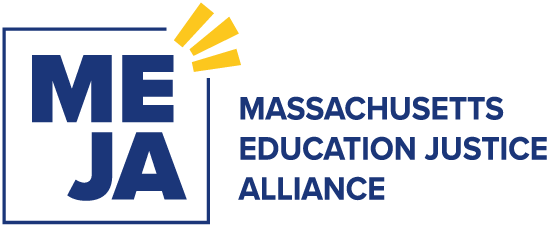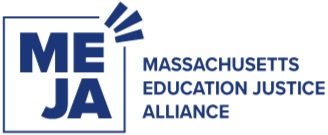School Funding Update & Next Steps for Education Justice!
Recently, the Massachusetts legislature passed, and Governor Baker signed, a new state budget that covers the 2021-2022 school year. Throughout the budget process, many of you joined us in advocating for full implementation of the Student Opportunity Act to support our preK-12 public schools, increased funding for public colleges and universities, and other education justice priorities. Thank you!
We won several of our priorities in this year’s budget, but we still have a long way to go to ensure that every student in Massachusetts has access to a high-quality public education. Now, a state budget surplus and significant one-time federal funding from the American Rescue Plan Act (ARPA) provide a major opportunity to jump-start far-reaching investments in our public education system.
Read on for more information about what was included in the state budget and the opportunity we have now to advocate for the equitable use of state funding and federal aid.
K-12 School Funding
Chapter 70 funding, the state’s primary support for local school districts, increased by $219.6 million to a total of $5.503 billion, putting the state back on track to fully implement the Chapter 70 portion of the Student Opportunity Act by 2027. However, the budget undercounts the number of students who will be enrolled in school this fall by as much as 30,000 students, and $90 million more is needed this year to ensure that those students receive adequate funding when they return in the fall.
Charter school reimbursement funding, which goes to local school districts to replace a portion of their state funding that gets diverted to charter schools, increased by $37.2 million to a total of $154.6 million. However, $31 million more is needed this year to ensure that the Student Opportunity Act commitment to fund charter school reimbursement funding is on track.
Special education circuit breaker funding, which goes to local school districts with special education students who require high-cost services, increased by $16.3M to a total of $373.3 million. However, $7 million more is needed this year to ensure that the Student Opportunity Act commitment to fund the circuit breaker is on track.
Funding for Public Higher Education
Direct funding to community colleges, state universities, and the UMass system increased by just $24.0 million to a total of $1.172 billion, which means that our public colleges and universities were essentially level-funded with adjustments for inflation. $136 million in additional funding is needed this year to implement the first year of the Cherish Act, which would reverse years of chronic underfunding at our public college campuses.
Funding for the SUCCESS program, which helps community colleges provide supports to increase degree attainment, particularly among students of color, increased by $3.5 million to a total of $10.5 million. This is a significant increase for a critically important program, especially as many community college students have dropped out or reduced their course load due to financial pressures brought on by the pandemic.
Funding for scholarship aid increased by $10.5 million to a total of $130.50 million, but still falls far short of the amount that would be needed to allow all Massachusetts students to graduate from public college without being forced to take on student debt.
State Budget Surplus and ARPA Funding for Education
While the pandemic has been a financial crisis for many low- and middle-income families, Massachusetts ended the last fiscal year with a budget surplus of over $4 billion. And through the American Rescue Plan Act (ARPA) passed by Congress and signed by President Biden in March, the federal government is making an unprecedented investment in public education from pre-K through higher education. ARPA is providing $1.658 billion for elementary and secondary schools in Massachusetts; $432.8 million for community colleges, state universities and the University of Massachusetts system; and $5.3 billion in discretionary funds controlled by the Legislature.
Now is the time to organize and advocate for how that money is spent to benefit students and our communities. MEJA is supporting the ‘Put the Frontline First’ budgetary recommendations to disburse the $5.3 billion in ARP funds coming to Massachusetts and center families and workers in your recovery efforts, instead of large corporations. The recommendations include:
$200 million for public schools and child care centers to purchase water bottle filling stations and filters certified to remove lead so that our children have access to clean drinking water;
$650 million to pay for two years of tuition and fees for all low-income students in community colleges, state universities and the University of Massachusetts, with wraparound support and services. In addition, these funds should also be used to attract a diverse educator workforce and provide debt relief for graduates of Massachusetts’ public colleges and universities who go to work in the state’s public schools;
$350 million to increase resources for community health clinics and public schools for mental health services, substance use disorder treatment, and services for people with severe disabilities; and
$450 million to create good jobs and invest in cleaner energy by installing solar panels, HVAC systems, and other energy efficient building improvements in our public schools.
Can you call your legislators today and ask them to support the ‘Put the Frontline First’ budgetary recommendations?
Thank you for everything you’ve done over the last several months to help get the Student Opportunity Act back on track, increase scholarship funding for public college students, and lift up the needs of students across the Commonwealth. Together, we can use this once-in-a-generation opportunity to deliver real change for students and make Massachusetts a national leader in valuing the education of all students.
Don’t worry about sounding professional. Sound like you. There are over 1.5 billion websites out there, but your story is what’s going to separate this one from the rest. If you read the words back and don’t hear your own voice in your head, that’s a good sign you still have more work to do.
Be clear, be confident and don’t overthink it. The beauty of your story is that it’s going to continue to evolve and your site can evolve with it. Your goal should be to make it feel right for right now. Later will take care of itself. It always does.

